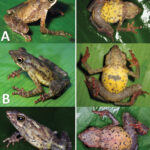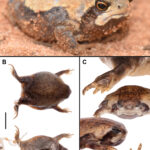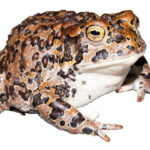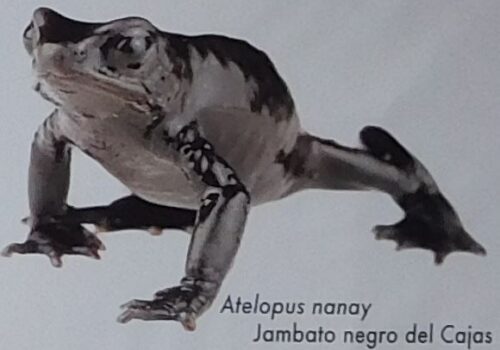- Atelopus onorei: A Jewel in the Clouds and a Symbol of Survival
- Taxonomy and Classification
- Natural Habitat: Enigmatic Cloud Forests
- Physical Characteristics: Small Wonders of Evolution
- Behavior and Life Cycle: Embracing the Rhythms of the Cloud Forest
- Ecological Role: The Amphibian Sentinel
- Threats and Conservation Status: Fighting for Survival
- Cultural and Scientific Significance: Beyond Biodiversity
- Conclusion: A Call for Stewardship and Conservation
Atelopus onorei: A Jewel in the Clouds and a Symbol of Survival#
Within the misty highlands of Ecuador’s majestic Andean cloud forests resides a remarkable little amphibian known as Atelopus onorei, a species whose very existence tells vivid stories of adaptability, resilience, and, perhaps, urgent warnings. Often overshadowed by larger, more charismatic fauna, this petite, colorful frog—commonly referred to as Onore’s Harlequin Frog—captures the essence of its habitat’s fragile beauty. Named after Giovanni Onore, a passionate Italian entomologist and conservationist who dedicated years documenting Ecuador’s precious biodiversity, this diminutive species encapsulates far more than merely an intriguing classification. Atelopus onorei embodies a lifeline connection to its sensitive ecosystem, forewarning researchers about environmental shifts well before larger changes become evident.
Intriguingly patterned and diminutive, Onore’s Harlequin Frog first appeared in scientific literature relatively recently, its formal description published in 2007. Yet, despite its modern academic introduction, this elegant amphibian swiftly rose in importance, becoming a symbolic sentinel for conservationists across South America. With populations languishing under the looming threat of extinction, the species’ tale is, sadly, one echoed across many delicate habitats in the tropical Andes. Yet alongside sobering struggles lie inspiring tales of survival, ingenuity, and human resolve that continue to shape ongoing conservation efforts centered around this beguiling creature.
Taxonomy and Classification#
Atelopus onorei belongs to the Anura order, family Bufonidae; a broad family famously known as the “true toads.” Despite their common name’s implications, many species within Bufonidae boast striking colors and delicate builds, belying their stereotypical image. The genus Atelopus itself is both extraordinary and problematic, existing exclusively in Central and South America’s lush tropical forests, and facing rampant threats from human encroachment and diseases. Approximately 100 species are recognized within this genus, yet tragically, many are endangered or already extinct.
The genus is famed for its brilliant coloration, a feature resulting from vibrant warning displays called aposematic coloration, alerting predators to the potent toxins coursing through these tiny amphibians. Amid the vibrant splashes of yellows, oranges, greens, and blacks stands our subject—Atelopus onorei. As part of its species group, it shares close evolutionary ties with several other geographically adjacent Atelopus species endemic to high-altitude Ecuadorian forests, particularly species like Atelopus bomolochos and Atelopus ignescens—frogs similarly battling alarming conservation battles.
Natural Habitat: Enigmatic Cloud Forests#
Stretched across the enigmatic cloud forests of Ecuador’s Andes, the habitat of Atelopus onorei is nothing short of mesmerizing by any naturalist’s standards. Cloud forests epitomize both fragility and tantalizing mystery, their canopies engulfed regularly in swirling mist, draping trees and foliage in perpetual droplets that nurture diverse, moss-covered ecosystems. At elevations between 2500 and 3000 meters, these Andean forests harbor cool temperatures, high humidity, and abundant rainfall, nurturing an incredibly rich array of life adapted uniquely to its moisture and altitude.
Within this intricate biome, Onore’s Harlequin Frog tends to favor proximity to fast-flowing streams and forest clearings where grasses and lower vegetation thrive. Such microhabitats not only provide abundant moisture, vital to the frog’s thin, permeable skin, but also host diverse insect populations upon which the species feasts. These pristine streams are critical not just for food and hydration, but also play an essential role in their reproductive cycles—a factor that makes environmental contamination or degradation profoundly detrimental to amphibian populations.
Physical Characteristics: Small Wonders of Evolution#
One glance at Onore’s Harlequin Frog and the observer is instantly captivated. This small amphibious wonder measures merely 25 to 35 millimeters in length (approximately the width of a human thumb). Yet within this small frame lies exquisite evolutionary refinement. Its form is elegant, slender-limbed, an agile jumper suited to quickly navigating slippery stones and leafy understory.
Bringing its charm vividly to life is the frog’s extraordinary coloring. Bright yellows and rich blacks define its delicate body, interspersed occasionally with olive or emerald green hues. These colors combine spectacularly in captivating patterns, unique among individuals much like a fingerprint for any attentive naturalist. Its vibrant design serves crucial biological purposes, warning potential predators against the cutaneous toxins secreted from skin glands. These toxins render Atelopus onorei less palatable and dangerous to potential predators—adaptations critical to survival in a dense, predator-rich ecosystem.
Behavior and Life Cycle: Embracing the Rhythms of the Cloud Forest#
Observing this tiny harlequin frog in its natural habitat, one witnesses behavior steeped in grace and precision. At dawn, hidden among lush greenery or nestled among sparkling, dew-kissed stones, individuals begin their daily routines: patiently hunting invertebrates such as small insects and arthropods to satisfy their carnivorous appetite.
Mating Calls and Reproduction#
Breeding typically aligns with the rainy season, a time when ephemeral ponds and rushing streams become abundant nurseries. Male Onore frogs become vocal during this period, their delicate yet persistent mating calls echoing gently through the cloud forests. This call, though modestly quiet, serves a paramount role in guiding females to suitable breeding territories. Upon successful pairing, females deposit strings of delicate eggs along rocks or leaves submerged in fast-moving water, safeguarding reproductive success. Tadpoles hatch soon afterward, remarkably adapted for survival within quick-flowing currents. Observing these fragile developmental stages provides profound insights into the critical need for pristine, uncontaminated waterways.
Ecological Role: The Amphibian Sentinel#
Like amphibians worldwide, Atelopus onorei plays pivotal roles within its ecosystem. Serving as an invaluable bioindicator species, its health reflects larger ecosystem well-being, detecting subtle, often invisible disturbances such as pollution, water acidity, or rising impacts from climate instability. Their role as insect predators maintains fragile ecological balances, limiting insect populations and, in turn, indirectly shaping vegetation dynamics and the broader animal community.
Conversely, despite potent defensive toxins, Onore frogs can occasionally fall prey to certain species—particularly specialized snakes or birds adapted to withstand the amphibian’s toxic arsenal. This delicate balance maintains biodiversity, natural selection pressures, and ecological cyclicality leading to a sustained and balanced cloud forest community.
Threats and Conservation Status: Fighting for Survival#
Like many contemporary amphibians worldwide, Atelopus onorei faces existential threats. Habitat destruction through deforestation, expansion of agricultural land, and urban development has reduced suitable habitat dramatically. Equally alarming is the pathogen causing chytridiomycosis—originating from the devastating fungal disease Batrachochytrium dendrobatidis—responsible for dramatic amphibian population declines across South America.
Consequently, conservationists and researchers strongly prioritize preserving this tiny frog. Currently categorized as “Critically Endangered” by the International Union for Conservation of Nature (IUCN), explicit protective measures prove vital. Conservation projects today include habitat protection, captive breeding initiatives, and stewardship by local communities. These combined efforts offer vital hope, reminding humanity of our collective responsibility in protecting vulnerable wildlife through resourceful collaboration.
Cultural and Scientific Significance: Beyond Biodiversity#
Whilst Atelopus onorei may not boast direct cultural symbolism akin to other charismatic megafauna like jaguars or tapirs, its symbolic ecological significance is undeniable. Its health signals ecosystem stability, thereby indirectly ensuring protection for precious freshwater resources, forest biodiversity, climate regulation, and local livelihoods sustained by healthy environments.
Further, in scientific circles, Onore’s Harlequin Frog symbolizes the delicate interconnectedness of biodiversity and climate change, forming part of crucial climate change impact studies. Research into its unique skin toxins also may yield biomedical discoveries, potentially influencing future medicinal solutions to human ailments.
Conclusion: A Call for Stewardship and Conservation#
In discovering the nuanced beauty and ecological significance of Atelopus onorei, one comes face to face with an embodied allegory of our relationship with nature itself: intricate, balanced, perilous, yet hopeful. Each frog carries forward its lessons about environmental safeguarding, resilience, interconnection, and the crucial role each organism plays—be it massive predator or a tiny cloud-forest frog.
It becomes our shared duty to ensure the survival of these wondrous creatures. Supporting conservation initiatives, educating communities, and demanding responsible stewardship empowers each of us to protect this tiny, vibrant jewel seriously threatened yet rich with immense ecological insight. May the delicate chirps of Onore’s Harlequin Frog remain melodies in cloud forests for generations to cherish.








